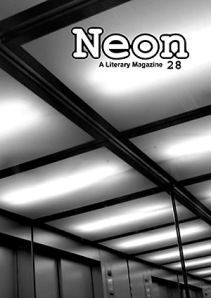Neon #28
–Reviewed by Barry Tench–
Sometimes you can look and look and then you have to really look; then you might see the light, even if it is the faint light of a Neon sign creeping across a hotel bedroom. You might listen in the dark, you might listen closely and perhaps you might make out a voice. It might be the voice Kerrie O’Brien describes in her poem ‘Blurring’:
‘Now I know I’m saying
None of this out loud.
But I’m hoping you’ll hear it in me
This time,
If you’re listening’.
Neon’s neat presentation and well placed poignant photographs make it an attractive proposition on a wet and wintry evening. What is even more impressive is the copy online, which you can also download for free and gently peruse over a mug of cocoa. I received #28 to review which says something for the longevity of Neon and its lasting appeal.
If there is a collective voice of Neon it has the terse and uncomplicated tone of a rail against the alienation of modern living. Take Danica Green’s ‘Me, You And Everything Else’:
‘blinding nights and charcoal days blending with the uniform
grey of what generally constitutes a normal life’…
…‘No one comes home. I sometimes take respite in my
stone-cold bed, and when I wake up from the dream, the world is
on fire.
I felt a kinship with writers trying to get to grips with the awkwardness of relationships: the etiquette of social interaction, the disquiet of staring down the twin barrels of loneliness and rejection. Despite tackling common poetic subjects, many of the poems use language that is both fresh and engaging. Kerrie O’Brien’s poem ‘Escape’ struck me for the line ‘it burns to be still’ and then again in ‘Every Morning’ she gives a cliché a nice turn when she writes ‘life off / the pedestal’. Catherine Owen’s poem ‘The Autopsy Report’ also stood out and I particularly enjoyed the phrase ‘post-haste to The Hall of Turning Things Inside Out’. In another poem, ‘The Climbing Accident’, Owen challenges us with images as surprising as ‘the T-bar of pharmaceutical barrenness’ and ‘her mind tallying up this budget of flesh’.
Patrick Gabbard makes interesting use of form in his poems. In ‘The Pines of Bucharest’ he manipulates spacing, line lengths and endings to give the poem an uneasiness. The jagged edge is perfectly suited to Gabbard’s surrealist images:
‘Between his thumb and forefinger her nipple –
She laughs again, louder this time before she collapses on his chest
And he thinks I am a warm dead galleon’.
Light in the darkness of contemporary life is captured in the short stories in Neon 28. Danica Green gives us an existentialist reflection that has its lyrical moments: ‘Nothing ever happens uninvited, the most beautiful and painful experiences welcomed through an open window’. Allana Balek’s short story ‘An Ending’ is another existentialist narrative that has some poetic images: ‘I turn off the music and we listen to the wind. I wonder how long the sunset will last and if we’ll ever get to see another one’, and ‘Clouds, she says. Dreams. Sunlight. Catchy music and long, lazy afternoons.’ It’s a nicely crafted piece with a hard hitting punch line.
There is strong imagery in Emily O’Neill’s poems too and the final stanza of ‘Last’ is very sexy (don’t get me wrong, I’m not complaining): ‘so you sat me on the desk and pushed my skirt up around my hips’. In ‘Before the Elegy’ there is imagery of a very different kind but just as striking: ‘a car crash or bullet in lieu of that coward needle’.
Neil Sloboda’s poems are typified by his use of unexpected images. For example, in ‘After the Buyout’ he writes:
Perched on the edges
of cold metal chairs,
we hectored one another
about how best to employ the time:
rip apart rotting decks, tear off asphalt shingles,
or fell dying trees behind our homes?
I also liked the unusual juxtaposition in this poem: ‘unpacking / daydreams and peanut butter crackers’. There is an evocative metaphor in ‘Hives’: ‘the diamond-backed lancers’ and I love the idea of ‘a flip-toy dog who never lands / on his feet’. Sloboda, like all the writers here, shows a willingness to experiment with language and imagery to stir our emotions.
Kirby Wright’s stories, ‘Ticking Clock’ and ‘Green Fruit’ veer toward prose poetry whilst giving us strong narratives dotted with clear imagery: ‘The highway skirted a pineapple field that stretched to the horizon’. But again there is this feeling of disconnection: ‘Did I walk through that door?’ and the battle of coming to terms with emotions in a harsh landscape ‘As he drove East, he prayed the baby would never be born’.
The light thrown by Neon 28 is modern and edgy but it keeps enough hidden in the shadows to keep us guessing at what is really there, what is hiding in the corners and under the bed. My biggest concern is that what we find there might dissolve in the bright light of day.



